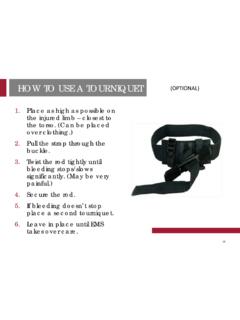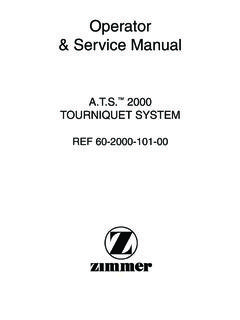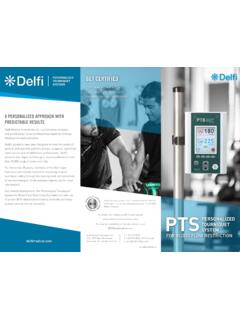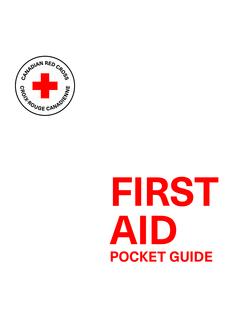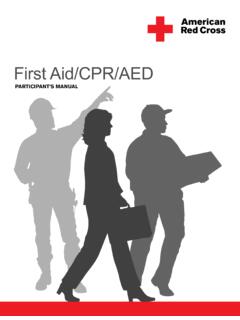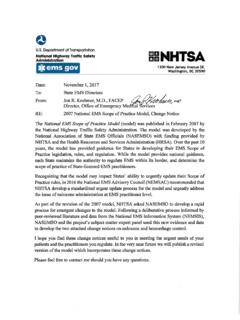Transcription of CARE UNDER FIRE - NAEMT
1 care UNDER fire SLIDE INSTRUCTIONAL POINTS INSTRUCTOR NOTES 1 Tactical Combat Casualty care February 2009 care UNDER fire First phase of TCCC is care UNDER fire . 2 Objectives DESCRIBE the role of fire superiority in the management of combat trauma. DEMONSTRATE techniques that can be used to quickly move casualties to cover while the unit is engaged in a firefight EXPLAIN the rationale for early use of a tourniquet to control life-threatening extremity bleeding during care UNDER fire . 3 Objectives DEMONSTRATE the appropriate application of the Combat Application Tourniquet to the arm and leg EXPLAIN why immobilization of the cervical spine is not a critical need in combat casualties with penetrating trauma to the neck.
2 4 care UNDER fire Guidelines 1. Return fire and take cover. 2. Direct or expect casualty to remain engaged as a combatant if appropriate. 3. Direct casualty to move to cover and apply self-aid if able. 4. Try to keep the casualty from sustaining additional wounds. Read the CUF guidelines. Note that the guidelines shown here will be published in the SEVENTH Edition of the PHTLS Manual. These guidelines are different from those in the Sixth Edition of PHTLS, which is the edition currently in publication. care UNDER fire 1 SLIDE INSTRUCTIONAL POINTS INSTRUCTOR NOTES 5 care UNDER fire Guidelines 5. Airway management is generally best deferred until the Tactical Field care phase.
3 6. Stop life-threatening external hemorrhage if tactically feasible: Direct casualty to control hemorrhage by self-aid if able. Use a CoTCCC-recommended tourniquet for hemorrhage that is anatomically amenable to tourniquet application. Apply the tourniquet proximal to the bleeding site, over the uniform, tighten, and move the casualty to cover. 6 care UNDER fire Prosecuting the mission and caring for the casualties may be in direct conflict. What s best for the casualty may NOT be what s best for the mission. When there is conflict which takes precedence? Scenario dependent Consider the following example 7 The scenario described here was Special Ops. The PRINCIPLES discussed apply to all combat units.
4 Go over each slide draw the audience in. care UNDER fire 2 SLIDE INSTRUCTIONAL POINTS INSTRUCTOR NOTES 8 Raid on Entebbe by VADM Bill McRaven 27 June 1976 Air France Flight 139 hijacked Flown to Entebbe (Uganda) 106 hostages held in Old Terminal at airport 7 terrorists guarding hostages 100 Ugandan troops perimeter security Israeli commando rescue One of the most famous hostage situations in history. 9 Raid on Entebbe by VADM Bill McRaven Rescue 4 July 1976 Exit from C-130 in a Mercedes and 2 Land Rovers Dressed as Ugandan soldiers Shot the Ugandan sentry Assaulted the terminal through 3 doors The tactics used were genius. DECEPTION, SURPRISE, and VIOLENCE 10 Raid on Entebbe by VADM Bill McRaven Here s what the layout looked like.
5 Black arrows show the entry paths of the Israeli commandos. 11 Raid on Entebbe by VADM Bill McRaven LTC Netanyahu the ground commander shot in chest at the beginning of the assault What should the corpsman or medic do? Disengage from the assault? Start an IV? Immediate needle decompression of chest? Imagine YOU are the combat medic on this operation. What would you do now? Ask several people in the audience what THEY would do. Note that this LTC Netanyahu was the brother of the future Prime Minister of Israel. care UNDER fire 3 SLIDE INSTRUCTIONAL POINTS INSTRUCTOR NOTES 12 Raid on Entebbe by VADM Bill McRaven As previously ordered, the three assault elements disregarded Netanyahu and stormed the building.
6 At this point in the operation, there wasn t time to attend to the wounded. NO medical care at the moment. Have to establish control of the tactical situation first. 13 Do seconds really matter in combat? LTC Netanyahu died from his wounds. The assault phase of the operation took 90 seconds. Did the 90-second treatment delay affect his chances of survival? Probably not. Would a 90-second delay in continuing the assault phase of the operation have made a difference? Absolutely. 14 Ma a lot Rescue Attempt by VADM Bill McRaven 15 May 1974 3 PLO terrorists take 105 hostages Schoolchildren and teachers When assault commenced, terrorists began killing hostages 22 children killed, 56 wounded The difference between a dramatic success and a disaster may be measured in seconds.
7 Look what even a momentary delay can mean to a hostage rescue operation OR OTHER TACTICAL ENGAGEMENTS 15 care UNDER fire If the firefight is ongoing - don t try to treat your casualty in the Kill Zone! Suppression of enemy fire and moving casualties to cover are the major concerns Not every casualty scenario is a hostage rescue, but these basic principles apply. care UNDER fire 4 SLIDE INSTRUCTIONAL POINTS INSTRUCTOR NOTES 16 care UNDER fire Suppression of hostile fire will minimize the risk of both new casualties and additional injuries to the existing casualties. The firepower contributed by medical personnel and the casualties themselves may be essential to tactical fire superiority.
8 The best medicine on the battlefield is fire superiority. Sustaining a minor wound in a firefight does not mean that you should disengage from the fight. 17 The most dangerous place Moving casualties during care UNDER fire is both difficult and dangerous. HAVE A PLAN AND REHEARSE IT! 18 Moving Casualties in CUF If a casualty is able to move to cover, he should do so to avoid exposing others to enemy fire . If casualty is unable to move and unresponsive, the casualty is likely beyond help and moving him while UNDER fire may not be worth the risk. If a casualty is responsive but can t move, a rescue plan should be devised if tactically feasible. Next sequence of slides shows the hazards of moving casualties before hostile fire is suppressed.
9 Unit members should be TRAINED to move themselves to point of first cover if able. Don t put two people at risk if avoidable. 19 While UNDER fire and without a weapon, Gunnery Sgt. Ryan P. Shane runs to Sgt. Lonnie Wells, to pull him to safety during USMC combat operations in Fallujah. Here is a dramatic example of casualty movement during care UNDER fire Read text care UNDER fire 5 SLIDE INSTRUCTIONAL POINTS INSTRUCTOR NOTES 20 Gunnery Sgt Shane attempts to pull a fatally wounded Sgt Wells to cover. Read text 21 Another Marine comes to help. Read text 22 Gunnery Sgt. Shane (left) is hit by enemy fire . Read text 23 The unidentified Marine heads for cover after Gunnery Sgt Shane, on ground at left, was hit by insurgent sniper fire .
10 Read text care UNDER fire 6 SLIDE INSTRUCTIONAL POINTS INSTRUCTOR NOTES 24 Casualty Movement Rescue Plan If you must move a casualty UNDER fire , consider the following: Location of nearest cover How best to move him to the cover The risk to the rescuers Weight of casualty and rescuer Distance to be covered Use suppression fire to best advantage! Recover weapon if possible DON T FORGET COVERING fire ! If possible, let the casualty know what you plan. 25 Types of Carries for care UNDER fire One-person drag with/without line Two-person drag with/without line SEAL Team Three Carry Hawes Carry 26 One-Person Drag Have other Instructors or students demonstrate Advantages No equipment required Only one rescuer exposed to fire Disadvantages Relatively slow Not optimal body position for dragging the casualty 27 Two-Person Drag Have other Instructors or students demonstrate Advantage Can get casualty to cover faster than with one-person drag Disadvantage Exposes two rescuers to hostile fire instead of one care UNDER fire 7 SLIDE INSTRUCTIONAL POINTS INSTRUCTOR NOTES 28 Video.

